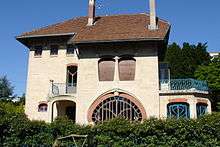Émile André
François-Émile André (August 22, 1871 – March 10, 1933) was a French architect, artist, and furniture designer. He was the son of the architect of Charles André and the father of two other architects, Jacques and Michel André.
François-Émile André | |
|---|---|
 | |
| Born | August 22, 1871 |
| Died | March 10, 1933 (aged 61) |
| Nationality | French |
| Alma mater | École des Beaux-Arts |
| Occupation | Architect |
| Practice | École de Nancy |

Life and career
André was born in Nancy, France. He studied architecture at the École des Beaux-Arts in Paris.[1]
From 1894 to 1900, he traveled to Tunisia, Sicily, Egypt, Persia, and Ceylon, during which time he produced numerous notebooks that included drawings, watercolors, and photographs. He had already worked in the studio of his father, Charles, André, then with Eugène Vallin, with whom he developed the principles of Art Nouveau.
He was slated to become a professor of applied arts and architecture with the École de Nancy, and is considered to be one of the group's principal architects. He built more than a dozen Art Nouveau buildings in Nancy between 1901 and 1912.
References
- Edmond Delaire, Les Architectes Élèves à l'École des Beaux-Arts 1793-1907 (Paris: Librarie de Construction Moderne, 1907).